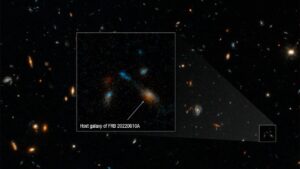
Astronomers used the Hubble Space Telescope to trace a fast radio burst back to a compact group of at least seven galaxies. This project will search for similar systems in simulations. Credit: Space Telescope Science Institute
Fast radio bursts (FRBs) are enigmatic millisecond-scale bursts of radio ways so powerful that we can observe them over most of the known Universe. Their “dispersion measure” – the later arrival time of low-frequency emission compared to high-frequency emission – traces ionised gas in the Universe, allow-ing FRBs to probe the previously “missing matter” that we think surrounds galaxies.
To interpret this data, FRB observations must be linked to large-scale cosmological simulations, which attempt to reproduce our known Universe from the era of the cosmological microwave background radiation to the present. This project will use results from such simulations to measure the predicted dispersion measure from FRBs. In particular, it will investigate if lines of sight can be found in simulated data that closely match the observed locations of FRBs in their host galaxies and surrounding environments.
| Student attributes | |
| Academic background | None |
| Computing skills | Can be taught – Python will be used |
| Training requirement | Python, SLURM, bash |
| Project timeline | |
| Week 1 | Inductions and project introduction |
| Week 2 | Initial presentation |
| Week 3 | Introduction to cosmological simulation suite |
| Week 4 | Learning to extract predicted dispersion measures |
| Week 5 | Identification of FRB environments – initial |
| Week 6 | Identification of FRB environments – final |
| Week 7 | Results for specific FRBs |
| Week 8 | Interpretation and analysis |
| Week 9 | Final presentation |
| Week 10 | Final report |